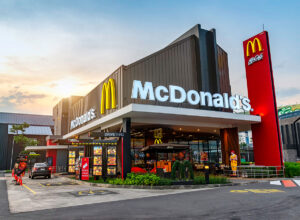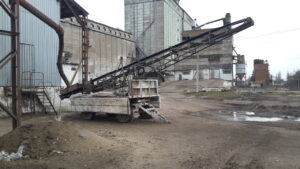
McDonald’s plans to open 11 restaurants in Ukraine in 2026, according to Vitaliy Stefurak, McDonald’s development director in Ukraine.
“Next year, we plan to open at least 11 restaurants. And in 2027-28, we expect to accelerate the development of the chain to 15 new establishments per year. We see prospects for development in Ukraine, so we are working to gradually increase investment,” he told the Interfax-Ukraine news agency.
According to Stefurak, nine openings were planned for 2025, but the plan was adjusted. De facto, in 2025, the chain will expand by 11 new establishments, and three new and one renovated restaurants will be opened by the end of the year. Last year, UAH 1.8 billion was invested in the development and renovation of the chain, and this year, about UAH 2 billion.
In 2025, the company achieved its goal by opening restaurants in the Zakarpattia region, the last region where McDonald’s had not previously been represented. As for future locations, according to the development director, the focus will be on increasing the number of restaurants in cities where the chain is already present.
“Our priority areas for development are Kyiv, cities with a population of over one million, regional centers and their satellites (provided there is sufficient traffic), as well as locations on popular highways. Today, we are concentrating on central and western Ukraine,” he said.
He named popular tourist locations as one of the promising areas (at the end of 2023, the chain opened a restaurant in Yaremche). “We will have the final decisions on the development plan for 2026 at the beginning of the year, but I will lift the veil a little: yes, next year there may be new establishments in tourist centers in western Ukraine,” Stefurak said.
The first McDonald’s restaurant in Ukraine was built on May 24, 1997, in Kyiv. Currently, 117 restaurants are operating in Ukraine, while another 15 restaurants are closed due to safety requirements.
According to YouControl, McDonald’s in Ukraine received UAH 9.9 billion in revenue in the first half of 2025, which is 26.9% more than in the same period last year. Net profit decreased to UAH 845.314 million compared to UAH 874.762 million in the first half of 2024.
The owner of PII “McDonald’s Ukraine Ltd.” is listed as MCD Europe Limited (100%, London, UK).

Spain has agreed to join the PURL project to purchase American weapons for Ukraine, Prime Minister Pedro Sánchez said in response to renewed criticism from US President Donald Trump over Spain’s unwillingness to increase military spending.
“We are a reliable country,” Sanchez said upon arrival at the European Council, where he also confirmed that Spain would purchase weapons from the US for Ukraine, El Pais reported on Thursday.
According to the publication, the country will participate in the US arms supply program (PURL), but the exact amount that Madrid is willing to spend has not yet been determined.

Ukrainian business is entering a new phase—an era of decisions that shape the future.
A world without rules requires a different type of strategy: faster, deeper, with an understanding of risks and opportunities.
On October 29, STRATEGY FORUM’2025 will bring together over 500 owners, CEOs, strategists, and C-level leaders to discuss:
– how to make decisions in an environment of constant change
– what strategizing rules work during wartime
– how AI and digital transformations are becoming the basis for synchronizing business and the state
– how to find breakthroughs and scale where others see limitations
– analytical presentations on global trends and development scenarios for 2026+
– strategic battle “Survival vs. Growth”
– interview with a state representative on the role of AI in strategic transformations
– Scaling case study panels – how companies maintain leadership during a crisis
– Interactive scenario thinking
– Final Fireside Chat – a conversation with leaders who make decisions that determine the future of markets.
STRATEGY FORUM’2025 speakers
Oleksandr Bornyakov, Deputy Minister of Digital Transformation of Ukraine
Mykhailo Prykhodko, Partner at EY-Parthenon in Ukraine
Kateryna Zagoriy, Member of the Board of Directors of Darnitsa, co-founder of the Zagoriy Foundation
Igor Smelyansky, CEO of Ukrposhta
Igor Liski, Founder of EFI Group investment company
Valeria Guzema, Founder of Guzema Fine Jewelry and Guzema Foundation
Dmytro Musienko, Member of the Board of PrivatBank for Retail Business
Oleksandr Bogutsky, CEO of Starlight Media
Dmytro Morozov, Deputy CEO of MHP for Customer Business Development
Petro Chernyshov, Chairman of the Supervisory Board of KAI, founder of the Kontora Pi initiative
Kateryna Libman, Founder of OKTO Family Group
Andriy Dligach, Chairman of Advanter Group, founder of the Board business community
Oksana Shchegelska, Partner at Strategic, Adjunct Professor at kmbs
Boris Shestopalov, Co-founder of Uparks, shareholder of HD-group and GFSGROUP
Volodymyr Savchuk, Author of books on business strategy
Roman Bondar, Managing Director of Korn Ferry Ukraine
Denis Bloshchynskyi, entrepreneur, scientist, public figure, ideologist of numerous social startups
Natalia Kryvda, Doctor of Philosophy, Chair of the Supervisory Board of the Ukrainian Cultural Foundation
Olga Dukhnich, Head of Demography and Migration at the Frontier Institute
Dmytro Kozlov, Member of the Board of Public Broadcasting
Andriy Kryuchkov, expert in strategic thinking development
Alona Zhupikova, founder of KA Group: “Our goal is to create a platform for sharing experiences that combines strategic analytics, practical case studies from Ukrainian companies, and global approaches to growth — from 2026 risk maps to Leader-to-Leader dialogues. This is an event where strategy ceases to be theory and becomes a working tool for those who lead. Join us as a team!”
Date: October 29, 2025
Location: Kyiv + Online
Organizer: KA Group
Contact: info@kagroup.ua | +38 (063) 247 94 74
Detailed program and team registration: https://kagroup.ua/sbf
Title partner WORK.ua
General partners MHP, PrivatBank
Official partner Linkos Group
STRATEGY FORUM’2025 – an event where strategy becomes energy for action.
Interfax-Ukraine news agency – information partner of the forum.
Dynamics of export of goods in january-may 2025 by most important items in relation to same period of 2024, %

Source: Open4Business.com.ua

Two large elevator complexes located in the Berezivka district of the Odesa region are being offered for sale on the OpenMarket electronic trading system (SE “SETAM” of the Ministry of Justice of Ukraine).
The first lot (No. 586642) is a mortgage complex of buildings with a total area of 18,270.7 square meters located at: Berezivka, Pristanichna Street.
The property includes administrative buildings, six grain warehouses, a weighing station, a grain dryer, a silo elevator, production facilities, and auxiliary infrastructure.
The auction date is October 31, and the starting price is UAH 85,086,000.
For more details about the lot and registration for the auction, follow the link
The second lot (No. 586647) is an elevator building with an area of 20,565.5 square meters with 106 items of movable property located in the village of Novoselivka, Berezivka district.
The auction date is November 3, and the starting price is UAH 19,580,000.
For more details about the lot and to register for the auction, follow this link
The sale is being conducted by a private executor within the framework of a single enforcement proceeding. The sale of such assets creates an opportunity to attract new investors to the development of the region’s agricultural infrastructure.
The OpenMarket auction (SE “SETAM” of the Ministry of Justice of Ukraine) is a simple and effective means of selling and purchasing property online. The online auction has been operating throughout Ukraine since 2014.

As part of its 19th package of sanctions, the European Union will impose a ban on transactions with five Russian credit institutions from November 12: Alfa Bank, MTS Bank, Absolut Bank, Zemsky Bank, and NKO Istina, according to an EU statement.
In addition, Belarusian Alfa Bank, Sberbank, VTB, Belgazprombank, BelVEB, as well as VTB’s subsidiary in Kazakhstan and VTB’s branch in Shanghai have been added to the EU sanctions list.
BAN, BANK, BELARUS, EUROPEAN UNION, RUSSIAN FEDERATION, SANCTION, TRANSACTION